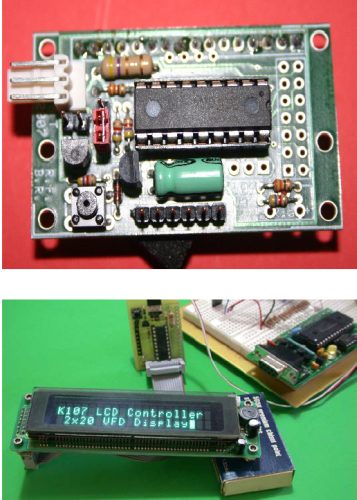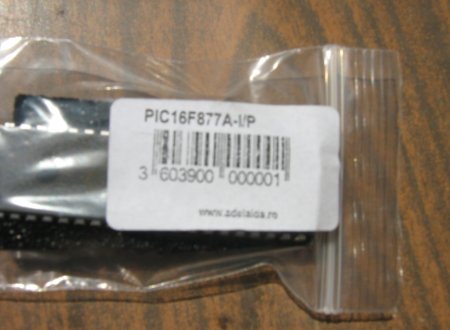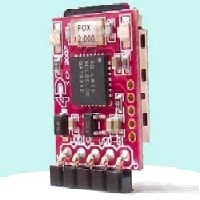
|

|
Forum Index : Electronics : New Charge Controller/Logger
| Author | Message | ||||
| GWatPE Senior Member Joined: 01/09/2006 Location: AustraliaPosts: 2127 |
The RS232 standard is not adhered to in the micro world much these days. 5V logic seems pretty normal now. Some older stuff is still fussy with 12V levels, and there will always be problems with distance transmissions. I will be looking into these units instead of needing a PC for data logging, when they become available. Gordon. become more energy aware |
||||
| mattvenn Newbie Joined: 31/03/2009 Location: Posts: 22 |
they're available to buy right now! |
||||
| GWatPE Senior Member Joined: 01/09/2006 Location: AustraliaPosts: 2127 |
the gadget linked to above. 
available soon. Gordon. become more energy aware |
||||
| Janne Senior Member Joined: 20/06/2008 Location: FinlandPosts: 121 |
I agree, many devices claiming to be RS 232 standard accept 0V / 5V signal levels. But if a device really has 5V / 0V outbound signal capasity it shouldn't be advertised as a RS232 device, instead it just should be "5V serial interface" I too will be interested to look at these devices more, when they became available. With the pic device on board, there is enough ram available to write the whole blocks on the mmc card. This is the worst problem with direct access from picaxe to mmc, not enough ram on board to write the full 512 bytes on a block. If at first you don't succeed, try again. My projects |
||||
| Dinges Senior Member Joined: 04/01/2008 Location: AlbaniaPosts: 510 |
[quote=Gordon]The RS232 standard is not adhered to in the micro world much these days. 5V logic seems pretty normal now. Some older stuff is still fussy with 12V levels, [...][/quote] The RS232 standard does NOT require 12V signal levels. Anything between +/- 3...25V (RX) and +/- 5...15V (TX) should do. If older stuff is fussy about needing 12V signals then it is because this older stuff doesn't adhere to the RS232 standard, as it should be able to work down to +/- 3V levels (RX) and +/-5V (TX). But if the board Vasi linked to outputs TTL signal levels (0...+5V) then it is by definition not RS232 (as Janne already said); not because the +5V would be 'too low' below 12V, but because the 0V should really be -3...-25V (RX) and -5...-15V (TX). RS232 requires symmetrical output signals (+/-), not asymmetric (0...+5V) as TTL. Peter. |
||||
| vasi Guru Joined: 23/03/2007 Location: RomaniaPosts: 1697 |
Ok, right. Then the "confusion" is some how on computer industry territory (the recent computers does not have required levels on serial ports). I think producers of that gadget are refering to protocol communication and not to voltage levels (..., 1200 bps, 2400, 9600, etc... as speed and then about data transmission ). Some of microcontrollers include hardware serial communication, others only a software simulation... Maybe is just a general reference to serial communications (something common, known by anyone: hey look, is rs232, that mean serial comm, isn't it?). Hobbit name: Togo Toadfoot of Frogmorton Elvish name: Mablung Miriel Beyound Arduino Lang |
||||
| RossW Guru Joined: 25/02/2006 Location: AustraliaPosts: 495 |
<i>the "confusion" is some how on computer industry territory (the recent computers does not have required levels on serial ports).</i> "Serial" is not "RS232". <i>Maybe is just a general reference to serial communications</i> Serial merely means one bit at a time, sequentially. The ubiquitous USB is serial. SATA hard disks are serial. RS232, RS423 and RS485 are all serial. Fibre optic systems are serial. Your SPIF etc (optical) links for your hifi are serial. Ethernet (10base2, 10BaseT, 100BaseT even gigabit ethernet) are all serial. Within the "Serial" category you have a whole host of sub-categories (synchronous, asynchronous, NRZI and hundreds more). At the physical interface level the voltage, current etc are relevant. Older systems that used to use 20ma current loop use exactly the same sense and timing as their RS232 counterparts. RS232 has reasonable noise immunity (thats basically why the -3v to +3v "deadband" is there), but there are other problems with RS232, especially at high speeds and long runs. 20ma loop (which is readily adapted to/from RS232 using little more than a couple of optoisolators) had much better noise immunity but suffered at high speeds. It is a pity that many people, especially those in technical and marketing roles, are either unaware of the difference between "Serial" and "RS232", or choose not to acknowledge the difference. It does indeed cause confusion and in some cases, damage of expensive equipment (you'll destroy the microcontroller if you stick RS232 up their serial input pin!) |
||||
| vasi Guru Joined: 23/03/2007 Location: RomaniaPosts: 1697 |
http://surducan.netfirms.com/RS232.html Hobbit name: Togo Toadfoot of Frogmorton Elvish name: Mablung Miriel Beyound Arduino Lang |
||||
| domwild Guru Joined: 16/12/2005 Location: AustraliaPosts: 873 |
Brian, Good idea to use a PIC as an upgrade to the Picaxe. A PIC means more I/O ports, more variables, floating-point arithmetic and assembler or C. Those of us new to electronics probably prefer a Picaxe with an associated loss of the advantages a PIC brings. Regards, Taxation as a means of achieving prosperity is like a man standing inside a bucket trying to lift himself up. Winston Churchill |
||||
| vasi Guru Joined: 23/03/2007 Location: RomaniaPosts: 1697 |
Another (possible) useful gadget: K107 - Serial LCD Controller - a very good .pdf documentation file 
You need to "spend" only one pin for comm. with this LCD. It comes as a kit for 9600 bps (PIC general use) or 2400 bps for PICAXE/8pin PIC's usage. Is useful for testing/debuging in development process or for final product (e.g., as LCD display for picaxe08M logger!!!). If you use it with Glenn's Windmill Controller/Charger (PICAXE28X), you can free 5 pins for other inputs! K107 web page address ---------------- More info: The project for PICAXE, with detailed info and examples of how to write Basic programs for PICAXE for displaying on LCD. The project for PIC's with detailed info. Hobbit name: Togo Toadfoot of Frogmorton Elvish name: Mablung Miriel Beyound Arduino Lang |
||||
| vasi Guru Joined: 23/03/2007 Location: RomaniaPosts: 1697 |
Another interesting resource: A weather station which use a Nokia 3310 display. Very nice - worth browsing entire site. And here another example of using the Nokia 3310 display (you can find it at a GSM center) Hobbit name: Togo Toadfoot of Frogmorton Elvish name: Mablung Miriel Beyound Arduino Lang |
||||
| GWatPE Senior Member Joined: 01/09/2006 Location: AustraliaPosts: 2127 |
The picaxe people already have an LCD interface ...033. I have one of these. Quite cheap as well. 1 output needed as well. The picaxe 08M only just has enough memory to display 4 readings on the LCD with useful tags. Decimal numbers, and changing sig digits can screw up the look as well. I have successfully displayed RPM, volts, Amps, W, on a 2 line x 16char LCD. This was useful for spot checking. The code has to be bypassed or rewritten for PC use. Gordon. become more energy aware |
||||
| vasi Guru Joined: 23/03/2007 Location: RomaniaPosts: 1697 |
Thank you Gordon, I just read the datasheet of AXE033. This is good. So, both PIC and PICAXE have 1 wire LCD interface. These LCD interfaces are built with microcontrollers and if you can't aquire one (any reason), then you must build one. I found here a 2 wire interface. Does not need a microcontroller. Only the HD44780 LCD, one 74LS164 8-stage serial to parallel converter, one resistor, one diode and one pot. And in this page is also the software for PICAXE which can be adapted to PIC software. Hobbit name: Togo Toadfoot of Frogmorton Elvish name: Mablung Miriel Beyound Arduino Lang |
||||
| vasi Guru Joined: 23/03/2007 Location: RomaniaPosts: 1697 |
Hi Bryan, I'm not yet ready to start but I'm acquiring components (also for a serial LCD - one or two wires, or both variants -, to have as much inputs as possible). Personally, I will try to contribute with JAL language and C if is possible (I think is ok if we can provide as many languages as possible?). We can borrow all what we can from Glenn's logger design but if you can come with a design is ok. I want to have all what Gill suggested. Didn't found PIC16F887 

Regards, Vasi Hobbit name: Togo Toadfoot of Frogmorton Elvish name: Mablung Miriel Beyound Arduino Lang |
||||
| vasi Guru Joined: 23/03/2007 Location: RomaniaPosts: 1697 |
I found a very interesting storage solution for PICAXE/PIC. Up to 2GB! http://www.picaxeforum.co.uk/showthread.php?t=12448 http://www.4dsystems.com.au/prod.php?id=22 http://www.instructables.com/id/Simple-mass-storage-for-your -microcontroller-proje/ 
|
||||
| GWatPE Senior Member Joined: 01/09/2006 Location: AustraliaPosts: 2127 |
commercial rs232 data logger This is a link to a logger that was on one of the Google popups. There is obviously more to it than just a pic chip and some EEprom, going by the cost. Gordon. become more energy aware |
||||